
|
![]()
Greatest Films of the 1930s
1930 | 1931 | 1932 | 1933 | 1934 | 1935 | 1936 | 1937 | 1938 | 1939
Title Screen Film Genre(s), Title, Year, (Country), Length, Director, Description 

L'Atalante (1934, Fr.), 89 minutes, D: Jean Vigo
L'Atalante was the last film from director Vigo (his second feature) before his untimely death at age 29, a few months after the film's premiere. Recommendations are to see the 89 minute restored version, rather than the studio-cut, butchered version, renamed The Passing Barge. This poetically-told, visually-rich, sometimes playful drama told the down-to-earth and simple story of French provincial girl Juliette (Dita Parlo) who married young river barge captain Jean (Jean Dasté), and then lived aboard his dingy vessel, named the Atalante. Two others, besides the crew, included grizzly, burly sea dog-sailor Père Jules (Michel Simon) with many strange mementos, a cabin boy, and Jules' six stray cats. Their new marriage as honeymooners disrupted the routines and the harmony of everyone on-board the cramped and dirty vessel. When the barge arrived in Paris, a bored Juliette left to see the nightlife and to escape from her husband's harsh ways. When she returned to the port, her broken-hearted and depressed husband had left without her. Pere Jules went to find Juliette - and they were reunited together. Noted for a beautiful underwater sequence and an exquisite love scene of the super-imposed husband and wife on separate beds.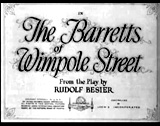


The Barretts of Wimpole Street (1934), 110 minutes, D: Sidney Franklin
MGM's beautifully produced, prestige piece of work was adapted from Rudolf Besier's 1930 stage play. The film was unnecessarily remade in Cinemascopic Metrocolor as The Barretts of Wimpole Street (1957), awkwardly starring Jennifer Jones as the only American performer in the British cast. The historical, emotional, soap-operaish heart-felt tale was set in 1845 in London, at the home of the Barrett family (at 50 Wimpole Street). The household (of three daughters and six sons) was dominated by the tyrannical, villainous and dictatorial control of the widowed and patriarchal Edward Moulton-Barrett (Charles Laughton), who believed that romantic love was sinful. The only child that he showed any preference for was his mostly bed-ridden, invalid eldest daughter Elizabeth Barrett (Norma Shearer), nicknamed "Ba," who could only manage sitting in a chaise lounge during the day. The nearly 40 year-old daughter occupied her time by reading and enjoying her pet cocker spaniel Flush. She also corresponded with Victorian literary poet Robert Browning (Fredric March), who came to her personally after one of her letters to pay a visit. The charming and handsome poet arrived and they happily discussed poetry, the arts, philosophy of life, and other engaging subjects (Browning: "We've known each other a mere half hour, and yet we've talked intimately of art and life and death and love"). Although overwhelmed by Browning's immediate ardent love for her, Elizabeth found herself also falling in love with Browning, and with newly-found vitality, health and happiness, was even able to struggle to the window to watch his departure. Her jealous, stern and over-protective father vigilantly observed the couple, and although he reluctantly allowed further visits, he strictly forbade Elizabeth from becoming romantically involved. As Elizabeth's romantic interest in Browning grew, so did her physical strength and ability to walk. Mr. Barrett also possessively ruled over the romantic couplings of his other children, mostly his youngest daughter Henrietta (Maureen O'Sullivan) and her military beau Captain Surtees Cook (Ralph Forbes). He brashly disallowed their illicit relationship (he called it a "filthiness"). He caught her in his company, viciously seized her wrists, forced her to confess to having sex with Cook, and harshly made her swear on a Bible that if she ever saw him again, he would disown her. Barrett's unreasonable stranglehold grew even tighter after he dismissed Elizabeth's doctor-recommended therapeutic retreat to the warmer climate of Italy, and threatened to have the family move to the countryside of Surrey to further curtail Browning's visits. To protest her devoted father's crushing control ("You're like a shadow over our lives"), Elizabeth sent word to Browning that she would meet him and runaway together. He responded that he wanted to marry her that very evening. To dissuade his disobedient eldest daughter after she denounced him, the abusive and obsessed Barrett claimed that only Elizabeth, out of all of his children, was conceived in love (not hateful rape), and insinuated that he had more than a fatherly love for her. He confessed that he wanted her all for himself: ("Nothing and no one can come between us, my child, my darling! You want me to be happy. The only happiness I shall ever know is all yours to give or take. You must look up to me and depend on me and lean on me. You must share your thoughts with me, your hopes, your fears, your prayers..."). [Note: The morals code of the 1930s tamped down the implications of his unnatural and incestuous interest in her, but allowed his admission that he exhibited "dragon" behavior.] Repulsed by his clingy, perverse sexual advances, Elizabeth decided to leave her home immediately to meet up and elope with Browning, get married, and move with him to Italy: ("He can't stop me. I don't belong to him anymore. He could kill me, but he can't stop me....I must go. To Robert....Until today I've never really known my father. I've even hoped I might confide in him, but now I know it would be hopeless. He'd crush me as he crushed my mother....He's cruel - cruel and pitiless and I'm afraid"); she left a note for her father that she was leaving to be married before taking one last look around with her dog Flush in her arms before departing. In the final scene, they were married, and would go on to live in Italy and become two of England's most beloved poets, writing sonnets and poems.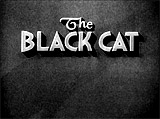


The Black Cat (1934), 65 minutes, D: Edgar G. Ulmer
Edgar Ulmer's classic, enigmatically disturbing horror film was from the 1930s Universal Studios, famed for its horror output. It featured spooky, moody cinematography and bizarre Expressionistic sets and became Universal's top-grossing film of the year. The visually intriguing, austere, landmark horror film masterpiece - a tale of European post-war anguish and death, was expressionistically directed. Its theme of the horrors of war would be echoed in his later films. It is considered by some to be the first American psychological horror film, with dark sexual repression, twisted relationships, and aberrant behavior (Satanism (devil worship), black mass orgies, necrophilia, pedophilia, sadistic revenge, murder and incest). Its fantastic architectural settings, expressionistic lighting, interesting geometric patterns and designs, and bizarre sets all added a richness to the strange tale. The film teamed two masters of the horror genre together: Dr. Vitus Verdegast (Bela Lugosi) who sought revenge against devil-cult worshipping Hjalmar Poelzig (Boris Karloff).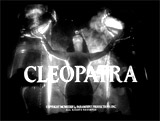


Cleopatra (1934), 102 minutes, D: Cecil B. DeMille
DeMille's extravagant production was a spectacular historical epic of the Egyptian Queen of the Nile. It was a modernistic 1930s costume spectacle that reshaped the Cleopatra story. The Paramount Studios film was campy, grandiose, unreal and ludicrous historically - filled with DeMille's usual mixture of sin and sex. Sexually-suggestive costumes adorned most of the female characters. Seductive, mysterious, and voluptuous Cleopatra (Claudette Colbert) flirted openly with Roman lovers. After the death of Julius Caesar (Warren William), she focused her attention on Marc Antony (Henry Wilcoxon). This kitsch film was well-known for three scenes: the infamous barge scene, an elaborately-staged sea battle (seen in montage), and Cleopatra's suicidal death scene from the bite of an asp.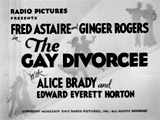


The Gay Divorcee (1934), 107 minutes, D: Mark Sandrich
This was notable as the film containing the first teaming of Astaire and Rogers in a starring role, although it was their second film together (earlier, they had appeared in Flying Down to Rio (1933)). It was based on the 1932 Broadway musical Gay Divorce. In a Brighton seaside hotel, Mimi Glossop (Ginger Rogers) (the film's 'gay divorcee') sought a way to acquire a divorce from her long-absent geologist husband Cyril Glossop (William Austin), by claiming he was adulterous. She was working with an incompetent lawyer Egbert Fitzgerald (Edward Everett Horton), her Aunt Hortense's (Alice Brady) ex-fiance, to create a fictitious set-up to prove infidelity for her divorce suit. In this amusing case of mistaken identity, dancer Guy Holden (Fred Astaire) was mistaken for writer/correspondent Rodolfo Tonetti (Erik Rhodes), who had been hired to be caught in a compromising position with her. Holden became interested in and infatuated by her, flirted with her and pursued her - becoming involved in her messy divorce scheme, and thought to be the 'hired' adulterer. Ultimately, when Guy romanced her and confessed his real love for Mimi, she finally was able to have Cyril admit that he was the true adulterer. Guy finally won Mimi when she agreed to marry him after obtaining a divorce. It included great music and dancing with Cole Porter's "Night and Day," "A Needle in a Haystack." and the Oscar-winning "The Continental" (the first time an Academy Award was given for Best Song).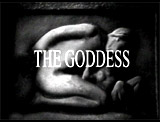


The Goddess (1934, China) (aka Shen nu), 73 minutes, D: Yonggang Wu
This melodramatic, heart-wrenching silent film about shame and social injustice told of a self-sacrificing mother-son relationship, between the un-named major character known as 'The Goddess' (Lingyu Ruan, an actress who committed suicide the following year at age 24), a street-walker in Shanghai, and her infant son (Keng Li as grown-up). [Note: Ruan's life was showcased in Stanley Kwan's biopic The Actress (1992) starring Maggie Cheung.] Her pimp was brutish, low-life gambler nicknamed 'the Boss' (Zhizhi Zhang). She fled from him, although he pursued her and forced her back to a life of prostitution. She used her hidden cash earnings to save for his schooling tuition, and provide him with a better life when he grew up. Her reputation as a hooker caused others to ostracize and shun her and her son, resulting in his expulsion by the school board, although she was championed by a kindly and sympathetic school principal. In the film's conclusion, once 'the Boss' located and misspent all of her cash, the anguished 'Goddess' killed him in self-defense (a broken bottle striking his head), but was sentenced to twelve years in prison. The principal personally adopted the son to give him a proper upbringing.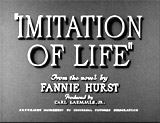

Imitation of Life (1934), 106 minutes, D: John M. Stahl
The first film adaptation of Fannie Hurst's melodramatic novel was about two hard-working women and their daughters. The sentimental soap opera told about an ambitious widow/working girl Beatrice Pullman (Claudette Colbert), her daughter Jessie (Rochelle Hudson at age 18), her black housekeeper/maid Delilah Johnson (Louise Beavers), and her maid's daughter Peola (Fredi Washington at age 19) whose light complexion enabled her to pass for white. Beatrice went into a successful pancake restaurant business with Delilah. The film dealt with disappointments in personal relationships and questions of identity and racial confusion.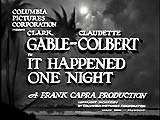



It Happened One Night (1934), 105 minutes, D: Frank Capra
Director Frank Capra's major Academy Award winning blockbuster film was a delightful, sparkling romantic comedy. Spoiled young heiress Ellie Andrews (Claudette Colbert) ran away from her disapproving millionaire father Alexander (Walter Connolly). She disguised herself for her travels to rendezvous with her boyfriend King Westley (Jameson Thomas), and took a cross-country bus trip from Florida to New York. On the bus, she ran into a recently-fired, out-of-work, no-nonsense newspaper reporter Peter Warne (Clark Gable), who agreed to help her when she lost all her money. He played along in order to get the exclusive story so he could acquire his job back. By film's end, they fell in love, almost against their wills. The film included a number of memorable scenes together, including the "Walls of Jericho" sequence and their competitive hitch-hiking scene.


It's A Gift (1934), 68 minutes, D: Norman McLeod
W. C. Fields' classic comedy was one of his best. Small-town grocery clerk, long-suffering Harold Bissonette (W. C. Fields) (pronounced 'Bee-soh-nay') was beset by harrassments from his children, his hen-pecking, nagging wife Amelia (Kathleen Howard), and his customers. Exasperated, he packed his family and belongings into their car for a trip out West to California to his "orange grove." It included classic slapstick scenes and routines, including: (1) the continual requests of customer Jasper Fitchmueller (Morgan Wallace) for Kumquats, (2) the ruination of his store by blind customer Mr. Muckle (Charles Sellon), and (3) the back porch swing scene when he attempted to take a nap and was continually interrupted by Baby Dunk (Baby LeRoy) and an insurance salesman (T. Roy Barnes) who asked: "Do you know a man by the name of LaFong? Carl LaFong? Capital L, small a, Capital F, small o, small n, small g. LaFong. Carl LaFong." Harold was able to prove everyone wrong when the shack on his piece of dried-up 'orange grove' land turned out to be valuable and lucrative as the location for a race-track.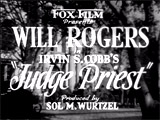


Judge Priest (1934), 80 minutes, D: John Ford
Popular humorist Will Rogers starred as long-time, small-town, justice-dispensing Judge William Priest, based upon the stories of Irvin S. Cobb. This sentimental story (criticized for some racist stereotypical characters) was later remade by director John Ford as The Sun Shines Bright (1953). The widowed judge, a Confederate veteran, used common-sense, plain-speaking and lack of pretense in his small-town legal dealings - in the post-bellum South (1890s Kentucky). Meanwhile, he also was a matchmaker for his nephew Jerome or "Rome" (Tom Brown), newly-educated as a lawyer, to romance next-door neighbor schoolteacher Ellie May Gillespie (Anita Louise), an unwed mother. Priest's high-society sister-in-law Caroline (Brenda Fowler) objected to the matchup, because she had an unknown lowly heritage (her poor mother died in childbirth and her father was unknown). Later, it was discovered that the town's blacksmith Bob Gillis (David Landau) was Ellie's missing father who had changed his name. Although charged for assault during a one-sided trial, Gillis was actually found to be defending his daughter's honor, and he was a Civil War Confederate hero who had secretly supported his daughter for years.


The Lost Patrol (1934), 74 minutes, D: John Ford
John Ford's adventure-war film featured an Oscar-winning score for oft-nominated Max Steiner. It provided the template for many future films about men during wartime surrounded by the enemy and awaiting death. During World War I in the year 1917, a small band of British cavalrymen were lost, cut off, and under siege in the hot Mesopotamian desert by Arab fanatics. They were doomed and suffering, struggling to survive against harsh odds in the waterless desert. One by one, the Arab enemy (hardly ever seen) mercilessly killed off the British soldiers with sniper fire until only their leader, the resolute Sergeant (Victor McLaglen), was left as the sole survivor.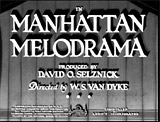

Manhattan Melodrama (1934), 93 minutes, D: W.S. Van Dyke II
MGM's crime drama was notable for the first film teaming of William Powell and Myrna Loy (who later would become famous with The Thin Man series), and were coupled together during their careers in a total of 14 films. A trivia item was that it was the only film that starred both Clark Gable and William Powell. It was also notorious for being the film that fugitive bank robber John Dillinger watched (for its similarity to his own life), prior to being killed by the FBI outside Chicago's Biograph Theatre, accompanied by a "Lady in Red" after a matinee showing in July of 1934. Its screenplay by Arthur Caesar won the Oscar for Best Original Story. In the plot beginning in 1904, two NYC boyhood friends were introduced: Blackie Gallagher (Mickey Rooney as 12 year-old boy, Clark Gable as a tough-guy adult), and Jim Wade (Jimmy Butler as boy, William Powell as a responsible adult). As a result of drownings in the East River during a holiday steamboat accident (General Slocum) that killed their parents, Blackie and Jim were rescued by Father Joe Patrick (Leo Carrillo). The two were raised as orphans together, and grew up to choose very divergent and opposite sides of the law. Blackie became a slick underworld gangster and shady racketeer who managed an illegal gambling casino (by paying off the authorities), while the studious Jim went to law school and chose to be a noble, honest, incorruptible and aggressive Ass't District Attorney, and ultimately was elected NY state governor. Blackie - and then Jim, both fell in love with the same charming woman Eleanor (Myrna Loy), who eventually married Jim when Blackie refused to choose a different, less dangerous life's path and commit to her. Blackie's involvement in gangland murders, including the killing of indebted gambler Manny Arnold (Noel Madison), brought him to the attention of his friend Jim, but without evidence, the case went unsolved. Their paths again crossed when Jim (as governor) fired his chief assistant Snow (Thomas Jackson) for corruption, and for making the false accusation that he had ignored Blackie's guilt in the Arnold case. When Blackie learned of Snow's scheming, he shot and killed Snow during an argument in a Madison Square Garden restroom during a hockey game, and was arrested, convicted, and imprisoned by his boyhood pal Jim. As governor, Jim refused to commute Blackie's scheduled execution for murder, until Eleanor informed him that Blackie had selflessly done it for the sake of Wade's future. Jim rushed to Sing Sing Prison to meet with Blackie, who turned down his offer (arguing that it would corrupt Jim's principles), and then went on to accept his electric-chair death without bitterness, attended by Father Joe - the prison's chaplain. As a result, Jim resigned his governorship when he acknowledged his willingness to compromise his principles, and reconciled with Eleanor who had briefly left him.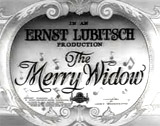


The Merry Widow (1934), 99 minutes, D: Ernst Lubitsch
Director Ernst Lubitsch's lavish, unique, stylistic musical was the definitive (and parody) version of Franz Lehar's 1905 operetta, set during the time of the downfall of the Hapsburg Empire. It was a remake of Erich von Stroheim's 1925 silent film (starring Mae Murray and John Gilbert), and would be re-envisioned by director Curtis Bernhardt as an extravagant Technicolored version starring Lana Turner (with dubbed singing by Trudy Erwin) and Fernando Lamas. It was notable that the 1934 version reunited its two stars for the last time: Jeanette MacDonald (in her second MGM film, before her many pairings with Nelson Eddy beginning with Naughty Marietta (1935)), and Maurice Chevalier. Lubitsch had already filmed MacDonald on three previous occasions, for The Love Parade (1929), Monte Carlo (1930), and One Hour With You (1932). In this film's plot set in 1885, King Achmed II (George Barbier) ineptly ruled the small Ruritanian country of Marshovia. His wife Queen Dolores (Una Merkel) was known to be involved in many extra-marital affairs. The King was determined to keep the kingdom's wealth at home, in order to prevent economic collapse. One of the country's rich widows, Madame Sonia (Jeanette MacDonald), owned 52% of everything in Marshovia, causing him worry if she should marry someone outside his domain. Therefore, he ordered womanizing and dashing playboy Prince Danilo (Maurice Chevalier) to pursue Madame Sonia to Paris, in order to romance, marry, and bring her back to Marshovia. The flustered Marshovian Ambassador Popoff (Edward Everett Horton) point-blankedly asked Prince Danilo: "Have you ever had diplomatic relations with a woman?" Later, the Ambassador called the scheme "cold blooded patriotism." Luckily, Danilo had already met the widow singing on her mansion's balcony, although she appeared solemn and forlorn (wearing all black and a veil). Along the way toward romancing her, Madame Sonia adopted a disguise as Fifi, and was at first thought by Danilo to be one of the ladies of Maxim's in Paris. After a case of mistaken identity, all was thought to end happily as they danced to the magical sound of "The Merry Widow Waltz" at an elegant Embassy ball. However, the widow rejected Danilo, and Danilo was subjected to a trial back in Marshovia for being a traitor: ("I'm guilty. Guilty of treason, failing in duty, of everything you want. But, most of all, I'm guilty of being a fool. Once in my life, I lost both my heart and my head. Therefore, I should be punished. Without mercy! Let my fate be a warning to every man"). In the film's ending plot twist, surprisingly, the widow testified on his behalf that he had truly tried to win her affection. In his prison cell, the couple were again entranced by the waltz tune, and exchanged wedding vows!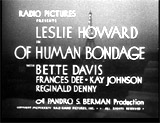


Of Human Bondage (1934), 83 minutes, D: John Cromwell
Director John Cromwell's first and best film adaptation of Somerset Maugham's tragic, classic literary novel marked the earliest critically-acclaimed role of Bette Davis. It became a turning point in her career, but Davis failed to win the Best Actress Academy Award in 1934. The pre-Code tale, a fallen-woman romantic melodrama was about an obsessive romance, and covered issues such as promiscuity, adultery, a birth out-of-wedlock, naked drawings, a mutually-destructive relationship, and retributive death from TB/syphilis during prostitution. Basically, the story entailed the development of an emotionally-compulsive infatuation and "human bondage" victimization between a sensitive, but lame (club-footed) young Englishman medical student Philip Carey (Leslie Howard) and a blonde vulgar, trampy, selfish waitress/barmaid Mildred Rogers (Bette Davis). At the film's start in the late 1800s, club-footed, sensitive artist Philip Carey - an Englishman who had been studying painting in Paris for four years, was advised by his art teacher Monsieur Flourney (Adrian Rosley) that his artistic work was mediocre and second-rate, and that he lacked talent and promise. Philip returned to London, England to take up studies to become a medical doctor. He soon became infatuated with blonde, lower-class, pale and anemic, coarse, trashy, slatternly and vulgar, Cockney-accented, illiterate tearoom waitress Mildred Rogers. He became preoccupied and smitten with the unfeeling and shallow female, even though she was disdainful of his club-foot, and they had nothing in common. The self-centered, disdainful and vindictive Mildred made "I don't mind" her standard response to him when he would express an interest in asking her out. Although he was attracted to Mildred, she was manipulative, repugnant, exploitative, callous, two-timing, shrewish and cruel toward him. Soon after, she stood him up for a date, claiming that her Aunt was ill, but her real excuse was that she had accepted a date from loutish, boisterous, womanizing traveling salesman Emile Miller (Alan Hale), another tearoom customer. Philip stalked her that night and realized she had lied to him. Nevertheless, he still failed to get Mildred out of his mind. His idyllic daydreams and night-dreams about her were far from reality. When Philip contemplated marriage with Mildred and proposed to her, she immediately declined his ring, telling him that she would instead be marrying Emile Miller. After the bitter rejection, Philip forgot all about Mildred when he fell in love with the attractive, gentle and considerate Norah Nesbit (Kay Johnson), an American romance-story tabloid writer (working under a masculine pseudonym Courtenay Paget) who was sympathetic toward him. Just when it seemed that Philip was finding love and happiness, Mildred suddenly reappeared and returned to him, claiming that Emile had abandoned her (and not married her because he was already married), after impregnating her. He took pity on tearful Mildred's penniless state and gave her apartment rent money and arranged to take care of her financially. As a result, Philip broke up with Norah due to his "bondage" to Mildred. Both Norah and Philip admitted how bondages existed in the interrelationships between people. After the birth of Mildred's child in the hospital, she had a cold reaction to her baby, fathered out of wedlock with Emile, and gave up its care to a nurse. During a dinner party with Mildred and Philip, one of Philip's fellow medical student friends, Harry Griffiths (Reginald Denny), flirted in an outrageous fashion with Mildred. Philip asserted that he had demonstrated his love for her by supporting her with an apartment, money and clothes, but when he also implied that she was "cheap" and "vulgar" - she slapped him, and announced her decision to run off with Griffiths to Paris - and finally, he ordered her out for good. For a second time after Mildred's departure, Philip found some comfort in his studies, and with 20 year-old Sally Athelny (Frances Dee), the daughter of one of his elderly patients Thorpe Athelny (Reginald Owen) in a charity hospital. However, it wasn't long before Griffiths told Philip that they had broken up: "Mildred and I are all washed up." After being abandoned, Mildred returned penniless, ill, and destitute - and now with her baby in tow. She moved in with Philip (because he couldn't afford a separate apartment for her) in exchange for housework, and Mildred at first was conciliatory to try and seduce him again. In the film's most famous sequence, when she became sexy and flirtatious with him in a low-cut negligee, Philip pushed her away in disgust. She viciously retaliated and berated him, ending her tirade by calling him a cripple: ("And after you kissed me, I always used to wipe my mouth! WIPE MY MOUTH!...You know what you are? You gimpy-legged monster? You're a cripple! A cripple! A cripple!"). She spitefully wrecked his apartment (with his nude drawings and books) and burned the securities/bonds he was given by his Uncle William Carey to finance his medical college tuition expenses, before leaving with her baby. Now destitute himself without the bonds, Philip had to leave medical school, but was fortuitously offered a foot operation to rid himself of his deformity. In the film's ending, Mildred once again had located Philip. She was sick, distraught, unwell, ill (with a deep cough) and destitute (with black circles under her eyes). Presumably, she was living as a streetwalker in a brothel, and her baby had died the previous summer. He gave her some money and a medical prescription, but denied her any other assistance, and left. Philip passed his exams and finished medical school (after receiving an unexpected inheritance from his deceased uncle), and in the film's last few moments, Philip learned that Mildred had died (from TB or syphilis?). Freed at last from his obsessive bondage, Philip decided to remain in England and propose marriage to Sally right away.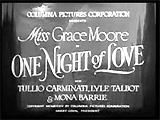


One Night of Love (1934), 84 minutes, D: Victor Schertzinger
Director Schertzinger's and Columbia's delightful, lavish operatic musical (which won Best Original Musical Score, the first time this Academy Award Oscar was given) was the most successful of a sub-genre of films with real-life opera stars. Earlier, real-life Metropolitan Opera soprano star Grace Moore had made her first two films for MGM in the early 1930s (A Lady's Morals (1930) and New Moon (1930)). In this romantic show-biz related drama, aspiring soprano opera singer Mary Barrett (Oscar-nominated Grace Moore) competed in a radio opera singing talent competition in New York City, but lost for her performance of "One Night of Love." The winner was awarded with training in Milan under the tutelage of renowned operatic maestro and vocal coach Guilio Monteverdi (Tullio Carminati). Nonetheless, the aspiring American singer, who hoped to achieve stardom in Europe, traveled to Italy anyway. She was accepted for training by the stern and demanding martinet Monteverdi after he heard her singing "Ciri-Biri-Bin" with the patrons in Cafe Roma - a cellar cabaret-restaurant. Although the eminent and brilliant Guilio invited her to live with him as a pupil, he vowed she would only be his musical protege without any romantic involvement. The controlling disciplinarian molded Mary during a serious regimen of difficult training exercises (Mary vowed at one point: "One day so help me, I'll murder that man!"), and also helped her to overcome stagefright. Her talent as a potential opera star (known as "La Barrett") noticeably grew. Entanglements and misunderstandings in a so-called love triangle grew between one of Guilio's ex-pupils and old flame Lally (Mona Barrie) and Mary while they were in Vienna. To anger and cause jealousy in her teacher, Mary announced she would give up her career with him, not appear to sing in an upcoming performance of Bizet's Carmen, and return to the US with her longtime friend and wealthy suitor Bill Houston (Lyle Talbot) and marry him. Guilio realized what was happening, told Mary that Lally would replace her on stage, and then confessed his love to Mary and proposed to her - they reconciled just before she went onstage to sing the Habanera in Carmen. However, their relationship again turned rocky after another argument and they appeared to break up permanently. Back in New York after Mary had accepted an offer to sing at the Metropolitan Opera House, the diva appeared to be nervous and unprepared during rehearsals for her debut performance of Puccini's Madame Butterfly. On the night of the opera's opening, "La Barrett" was strengthened and encouraged to perform calmly, triumphantly and flawlessly after viewing Monteverdi in the opera's prompter box (under the stage) - who whispered "I love you" to her.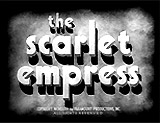

The Scarlet Empress (1934), 110 minutes, D: Josef von Sternberg
Josef von Sternberg's startling, dark, visually opulent, hauntingly expressionistic, and mostly fictional biopic was about Prussian-born Princess Sophia Frederica (Marlene Dietrich as adult, Maria Riva as child). This semi-erotic tale of 18th century Russia was one of the most daring films of the Hays Production Code era, featuring, among other things, immorality, nudity and open sexual decadence. The film also featured extravagant sets and von Sternberg's trademark stylization, as well as great performances. For a six-year period, Marlene Dietrich was Svengali von Sternberg's favorite leading lady - this was their sixth film together (and last great collaboration). In the film's main plot, the young, naive, tremulous bride-to-be Sophia Frederica (Marlene Dietrich) was brought in an entourage on a seven-week journey to Moscow, Russia for an arranged marriage to Grand Duke Peter III (Sam Jaffe), nephew of domineering, elderly Empress Elizabeth (Louise Dresser). Upon their arrival, the Empress renamed her Catherine. The hope would be that she would improve the royal blood line, but Catherine was revulsed by her bumbling, idiotic, and childlike husband-to-be, and instead became romantically involved with opportunistic womanizer Count Alexei (John Lodge) and other military figures. After the birth of a child (of questionable fatherhood), Catherine heard rumors that the Grand Duke had plans to remove her from power and execute her once the Empress passed away; he was also hinting that he would marry his black-haired, feral-looking mistress Countess Elizabeth 'Lizzie' Varonsoff (Ruthelma Stevens). Soon after in 1762, the Empress died, and Catherine realized the gravity of the new political situation once Peter assumed power and gloated over the open coffin of the Empress. Fur-hatted Catherine had other plans ("Catherine coolly added the army to her list of conquests"). She was slowly transformed into a sexually-depraved dominatrix ruler with a whip. As predicted, after the death of the Empress, Peter put Catherine under house arrest: ("My wife is not to leave the palace. She's under arrest until further orders. Am I the Emperor of Russia, or am I not?"). To consolidate his power, Peter planned to eliminate her. In the bell-ringing conclusion, Catherine (in the white uniform of a male Cossack) had engineered a coup d'etat with the military and Count Orloff (Gavin Gordon), to coordinate the downfall and assassination of Peter III. With the support of the military behind her, she escaped from the palace and rode with a cavalry batallion led by Count Alexei, as he proudly and succinctly affirmed the transfer of power: "Exit Peter III. Enter Catherine II." They proceeded to a military encampment to prepare for the toppling of Russian Emperor Peter III in the palace. The cavalry soldiers (with Catherine in the lead) noisily rode their horses back to the palace; they galloped up the grand staircase into the interior of the palace, and assembled in the throne room where she was crowned as Catherine the Great, Tsarina of Russia. The film's last lines were delivered by Count Orloff to Emperor Peter who had been dethroned: "There is no emperor. There is only an empress." She victoriously ascended the throne with her white stallion horse to take her rightful place before her royal forces after her seizure of power.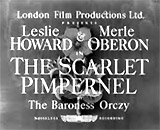


The Scarlet Pimpernel (1934, UK), 97 minutes, D: Harold Young
This UK film from director Harold Young was one of the greatest historical-adventure films ever made. It told about the double-life of an 18th century aristocrat who disguised himself to save French nobles from Robespierre's Reign of Terror in France. First written as a stage play produced in 1903, it became the first novel (published in 1905) in a series of historical fiction novels written by Hungarian-born English novelist and playwright Baroness Orczy. In the year 1792, during the time of the bloody French Revolution (with the Reign of Terror led by Robespierre), Sir Percy Blakeney (Leslie Howard) posed as a mild-mannered, chivalrous and rich English aristocrat. He was newly married to a beautiful French woman, Lady Marguerite (Merle Oberon). As an English nobleman, he was deeply concerned by news of the slaughter of the aristocratic French, including the deaths of the Marquis de St. Cyr and his family. The devious French Republic's ambassador to England, Monsieur Chauvelin (Raymond Massey) led a Revolutionary tribunal that condemned members of the aristocracy to death. To rescue innocent but condemned French noblemen who faced the guillotine, Sir Blakeney proposed adopting a new mysterious identity - as a dashing and mysterious hero known as "The Scarlet Pimpernel." He took his name from the symbol on his family crest - a deep-red colored English primrose. The Pimpernel's trademark was to leave behind a small red flower - a pimpernel, sometimes in the form of red wax with a floral design (created by the imprint of his signet ring). The name was immortalized in a poem that he recited: "They seek him here, they seek him there, those Frenchies seek him everywhere. Is he from heaven is he from hell -- that damned elusive Pimpernel." Blakeney was the organizer of a daring band of conspirators in a 'secret society' who saved imprisoned French aristocrats, noblemen, and royalists from death (from "Madame Guillotine") by smuggling them out of France to England. He took many expeditions to Paris with his fellow compatriots, including his wife's brother Armand St. Just (Walter Rilla), to secretly rescue condemned individuals, while mocking the French Revolutionaries. Blakeney was unable to reveal his secret identity to his new wife when he feared she would be endangered, or that she would divulge his hidden mission. Because of long absences, his costumed attire, his indolence, and his vapid, foppish 'gay' or 'dandy' mannerisms and affectations (to hide his true identity), Blakeney lost the respect of his beloved wife, who remembered him as he used to be before he became limp-wristed and weak. Ironically, she became enamoured and infatuated with her husband's romantic, charming alter-ego. Robespierre became enraged by the Pimpernel's activities, and dispatched villainous Chauvelin to Dover, England, to target members of his arch-enemy's underground movement. In England, Chauvelin learned that Lady Blakeney's brother Armand was allied with the Pimpernel, and coerced her into cooperating in his search, in order to save Armand (she was told he had been captured and arrested by French spies). However, the clever escape artist Sir Percy Blakeney eluded a trap in a library that was set by his would-be captor during a fancy ball held at Lord Grenville's (Allan Jeayes) home. Meanwhile, Lady Blakeney was astounded to learn that the Pimpernel was her own husband. The clue to his real identity was hidden in a huge family portrait of a Blakeney ancestor (Percival Blakeney, the 1st baronet) in her husband's private study; the painting showed him wearing a carved signet ring in the shape of a red primrose (or scarlet pimpernel flower) on his right hand. As the startling revelation came over her, the camera slowly zoomed toward her face; she called out: "Percy. Percy!" and raced from the room. She rushed to her husband's side at a French seaside rendezvous site (a tavern known as "Lion d'Or"), hoping to save him or die with him. There, after arriving ahead of her husband, she was captured and arrested by Chauvelin (who planned to be disguised as a priest) and she was forced to lure Percy to the inn at 10 pm with a lighted candle from a window as an "all-clear" signal; there, Percy was forced to surrender to Chauvelin (in exchange for Lady Blakeney's release). During this climactic confrontational sequence, Sir Percy merged himself into his 'Scarlet Pimpernel' disguise, and was able to outfox, outwit and fool Chauvelin, thus defeating him. The French soldiers in a firing squad that were ordered to execute Blakeney were actually his own men in disguise. Blakeney and his wife were finally reunited and set sail across the Channel back to England (the film's last line: "Look Marguerite, England!"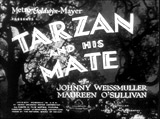



Tarzan and His Mate (1934), 93 minutes, D: Cedric Gibbons, Jack Conway
This second MGM/Weissmuller Tarzan film, probably the best of the series, was a sequel to Tarzan the Ape Man (1932). This was the second of five films in which Maureen O'Sullivan played the part of Tarzan's mate. It was a sexy adult version, with Jane swimming nude and wearing revealing animal-skin outfits. There were also great action sequences including a climactic rescue. Jane Parker (Maureen O'Sullivan) had left civilization and joined Tarzan (Johnny Weissmuller) in the jungle treetops. Her ex-fiancee Harry Holt (Neil Hamilton) had returned to Africa with greedy ivory hunter/poacher Martin Arlington (Paul Cavanagh) to search for the hidden elephant burial grounds and to bring Jane back. Tarzan was tricked into leading them to the burial grounds.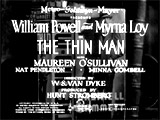



The Thin Man (1934), 93 minutes, D: W.S. Van Dyke
Van Dyke's mystery-detective film was based on writer Dashiell Hammett's 1934 detective story. It was the first (and considered the best) in the entertaining series of six films. It featured the debut of the charismatic, beloved team of Powell/Loy as the suave, sophisticated, happy, leisure-class and fun-loving detective couple. There was witty dialogue, clever bantering between the two, including wisecracks, sophisticated humor, romance, and an intriguing plot. In the story, retired police detective Nick Charles (William Powell) and his wealthy wife Nora Charles (Myrna Loy), with the help of their dog Asta, were asked to investigate the disappearance/murder of Dorothy Wynant's (Maureen O'Sullivan) missing father - screwball inventor Clyde Wynant (Edward Ellis).


Viva Villa! (1934), 115 minutes, D: Jack Conway, Howard Hawks (uncredited)
This action-packed western drama was a loose-historical account of Mexico's legendary bandit/hero, featuring probably Wallace Beery's best screen performance ever. Pancho Villa (Wallace Beery) began as a bandit leader in the Mexican hills who stole from the rich and assisted the poor. He later battled with the Federales in the revolutionary struggle for the Mexican Republic. After his victory, he reverted to banditry, but then returned again in triumph to declare himself President of the country, after which he soon retired to his ranch. Additional characters included an aristocratic woman Teresa (Fay Wray) who fell in love with him, and an American journalist Johnny Sykes (Stuart Erwin) who helped to create the Villa legend.